Temperature effects on a nano-porous ZnCo2O4 anode with excellent capability for Li-ion batteries
Abstract
In this study, nano-porous ZnCo2O4 anodes are synthesized via a hydrothermal method with subsequent annealing at different temperatures. X-ray diffraction (XRD), Brunauer–Emmett–Teller (BET) analysis, scanning electron microscopy (SEM), and transmission electron microscopy (TEM) are carried out to study the crystal structure, pore size distribution, surface morphology and characteristics, respectively. With increasing sintering temperature, the morphology of ZnCo2O4 turns to sphere-like with a porous structure. The as-prepared porous ZnCo2O4 nanospheres synthesized at the optimal condition of 600 °C (ZCO-600) demonstrate a high capacity of 1800 mA h g−1 and a good retention performance of 1242 mA h g−1 after 30 cycles. The AC data shows that the ZCO-600 anode gives a lower impedance compared to ZCO at other temperatures. The porous nanostructure and large surface area are responsible for the superior performance. Moreover, nano-porous ZCO synthesized at 500 °C gave a better cycle performance and much higher rate capability compared to the samples synthesized at temperatures of 600 °C and 700 °C, because of its superior structural properties.


 Please wait while we load your content...
Please wait while we load your content...